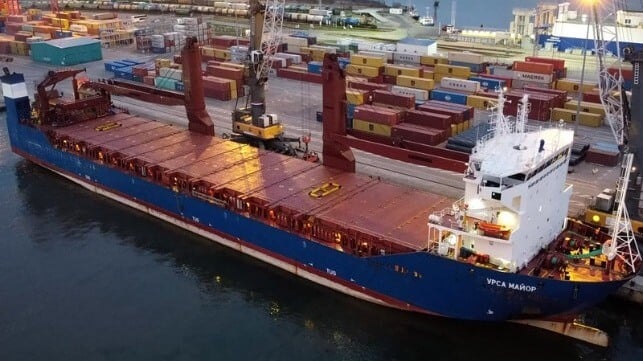Russian Military Sealift Ship Sinks After Engine Room Explosion
Russian Cargo Ship Sinks Near Spain

On Monday, a Russian cargo ship, the Ursa Major, sank in the Strait of Gibraltar after an explosion in its engine room. The incident has left two crew members missing, while 14 others were rescued. This event raises concerns about maritime safety and the geopolitical implications of Russian naval operations in the Mediterranean.
Incident Details
The Ursa Major was traveling eastbound in the Strait of Gibraltar around 12:30 PM local time when the explosion occurred. Following the blast, the ship slowed down and began to list dangerously. The situation quickly escalated, prompting a response from nearby vessels. The Spanish Navy warship Clara Campoamor and a good Samaritan vessel, the Sparta, another sanctioned Russian cargo ship, rushed to assist. While 14 crew members were successfully rescued, the fate of two others remains uncertain as search efforts continue.
The Ursa Major was operated by a subsidiary of Oboronlogistika, a Russian defense company under international sanctions. This vessel has been a key part of Russia’s supply routes to Tartus, Syria, which serves as a significant naval base for the Russian Navy in the Eastern Mediterranean. The U.S. Treasury Department included the Ursa Major in a package of sanctions related to the ongoing conflict in Ukraine, highlighting the vessel’s strategic importance in Russian military logistics.
After the sinking, the Sparta resumed its journey at a reduced speed, heading towards Port Said, Egypt. The incident raises questions about the safety of maritime operations involving sanctioned vessels and the potential risks associated with their activities in international waters.
The Cost of Carbon Compliance Leads the Discussion at the ABS Hellenic National Committee
Geopolitical Context
The sinking of the Ursa Major occurs at a critical juncture for Russian operations in the Mediterranean. The stability of the Russian-backed regime in Syria has been increasingly uncertain. Reports indicate that Russian forces have withdrawn from many positions in Syria, concentrating their presence at Tartus and the nearby Hmeimim airbase. This shift suggests a potential reevaluation of Russia’s military strategy in the region.
Negotiations are reportedly underway between Moscow and the leadership of the militant group Hayat Tahrir al-Sham regarding the future of Russian forces in Syria. The Institute for the Study of War has noted that while Russian troops have retreated from their forward bases, their coastal positions remain intact. However, the long-term viability of these bases is in question, as ongoing discussions may lead to further changes in Russia’s military footprint in the region.
The Ursa Major was reportedly carrying heavy lifting equipment, including two large crawler cranes, which has led to speculation about its intended destination. Some analysts believe the ship may have been on a mission to support the removal of Russian military equipment from Tartus. The vessel’s declared destination was Vladivostok, although its master claimed that the holds were empty. This ambiguity adds another layer of complexity to the incident and its implications for Russian military logistics.
In conclusion, the sinking of the Ursa Major not only highlights the dangers of maritime operations involving sanctioned vessels but also underscores the shifting dynamics of Russian military presence in the Mediterranean. As the situation unfolds, the international community will be closely monitoring developments in this strategically important region.
